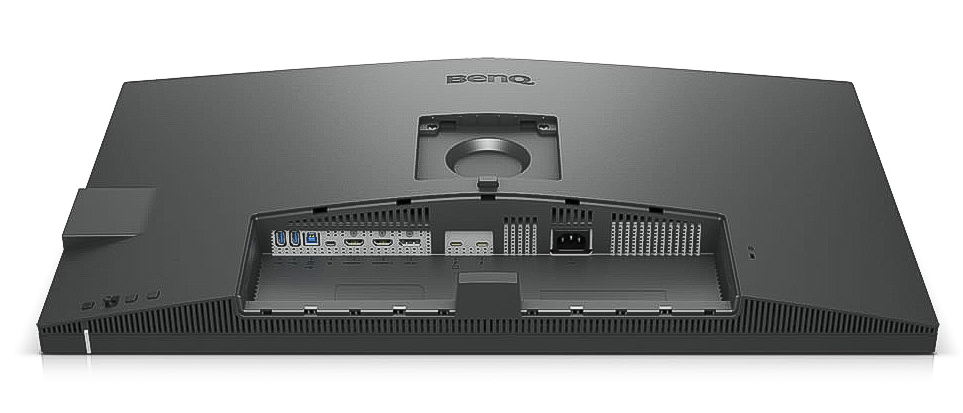Digital Camera World Verdict
There are differences in what photographers and designers want from a pro-level monitor, but the 4K resolution and 32-inch size display works is a sweet spot for both and BenQ continues to deliver exceptional value for money when it comes to performance-versus-price. If you’re primarily buying a monitor to prepare images for printing then one of BenQ’s dedicated photo monitors – the SW321C is the equivalent – is the better option, but for everything else the PD3220U is more than capable and at a significant cost saving too.
Pros
- +
32-inch and 4K delivers great definition without fine details being too small
- +
Thunderbolt 3 connectivity enhances flexibility
- +
'Hockey Puck’ G2 wired remote controller adds convenience
- +
Factory calibrated display for accuracy
Cons
- -
Limited Adobe RGB coverage for print-making
Why you can trust Digital Camera World
If you are considering stepping up to a 4K resolution photo monitor or, indeed, thinking of upgrading to a bigger display, then BenQ’s SW321C would certainly be on the short list. BenQ is building a reputation for affordable high-performance photo monitors, but the SW321C's price may make this too expensive for many right now. If you’ve already put a 32-inch display and 4K UHD resolution on the wish list, there aren’t really a lot of cheaper alternatives… except if you browse through the BenQ monitor catalogue, you’ll find the PD3220U which is one of the company’s DesignVue series models. It’s primarily aimed at graphic designers, but a quick survey of the key specs shows that it shares quite a bit with the Benq SW321C at least in terms of the physical features and even some display capabilities – but is noticeably cheaper.
So OK, this is a monitor primarily made for designers and it has a number of design-orientated features, but some of these are equally useful to photographers as well… especially if you’re doing a bit of graphic design work too, either for yourself or clients. The key aspects for photographers are that it’s an individually factory-calibrated display with the ‘sweet spot’ specs – for image editing especially – of a 31.5-inch panel and 3840x2160 pixels resolution which represents 140 ppi so fine detailing is still easy to see at a comfortable viewing distance.
Handling
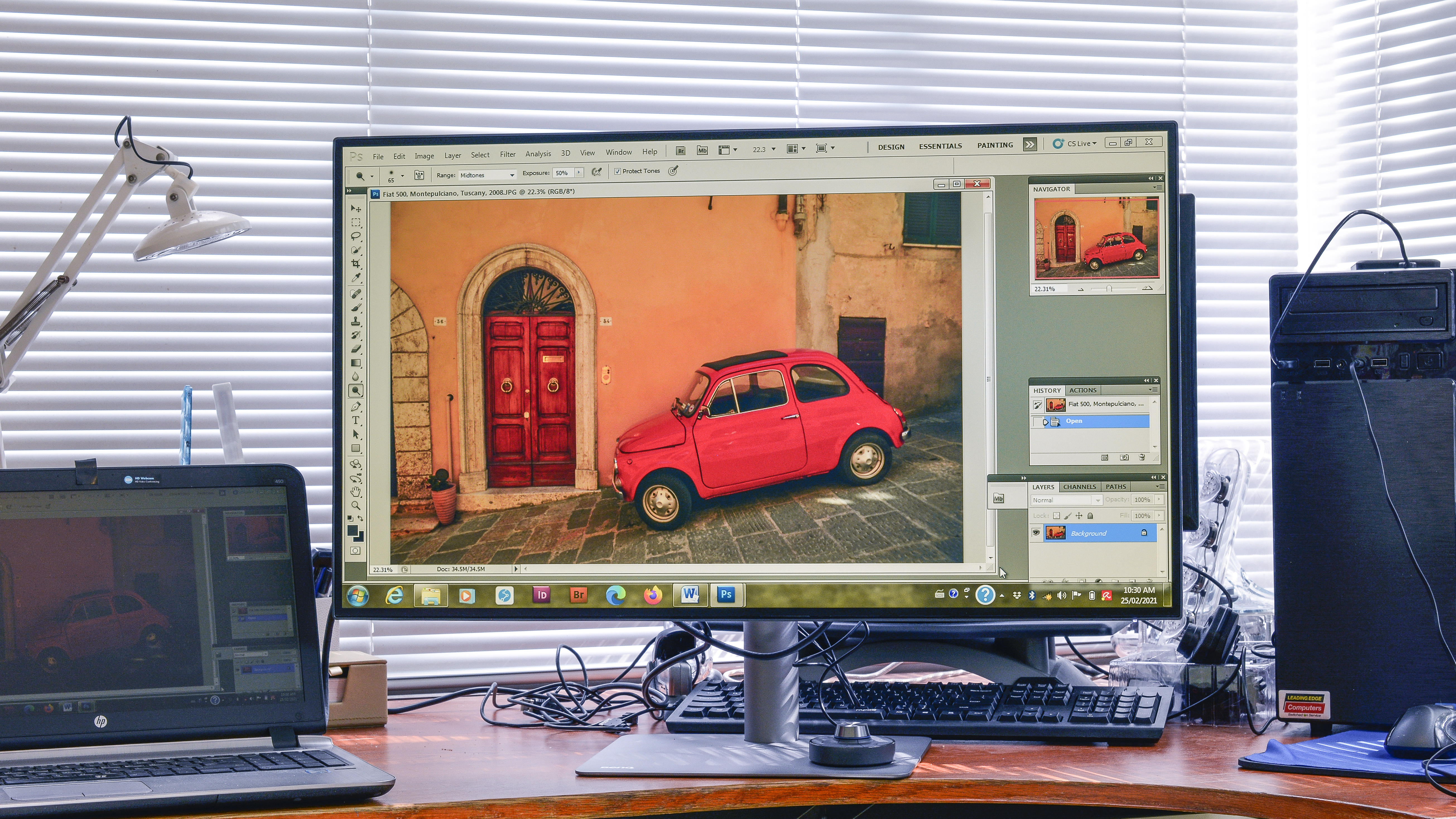
BenQ emphasizes the DesignVue monitors are designed to provide comfortable viewing over longer periods of time without creating eye fatigue. The PD3220U has a matte anti-glare screen surface, and both Darkroom and Low Blue Light viewing modes as well as flicker-free technology. LCD panels actually switch on and off at a very high frequency which and while you can’t really see this flickering, it’s a major cause of tired eyes if you’re staring at the screen for hours at a time. The Low Blue Light mode filters out the blue wavelengths that cause eye strain.
On the physical side, the PD3220U has clearly been styled with fashion-conscious designers mostly in mind so it’s actually much smarter looking than the PhotoVue models, with a rounded support column and wide stand that are both finished in contrasting silver-grey.
The stand provides a height adjustment range of 15 centimetres and allows for both tilting and swiveling plus a full 90-degree pivot for a portrait orientation.
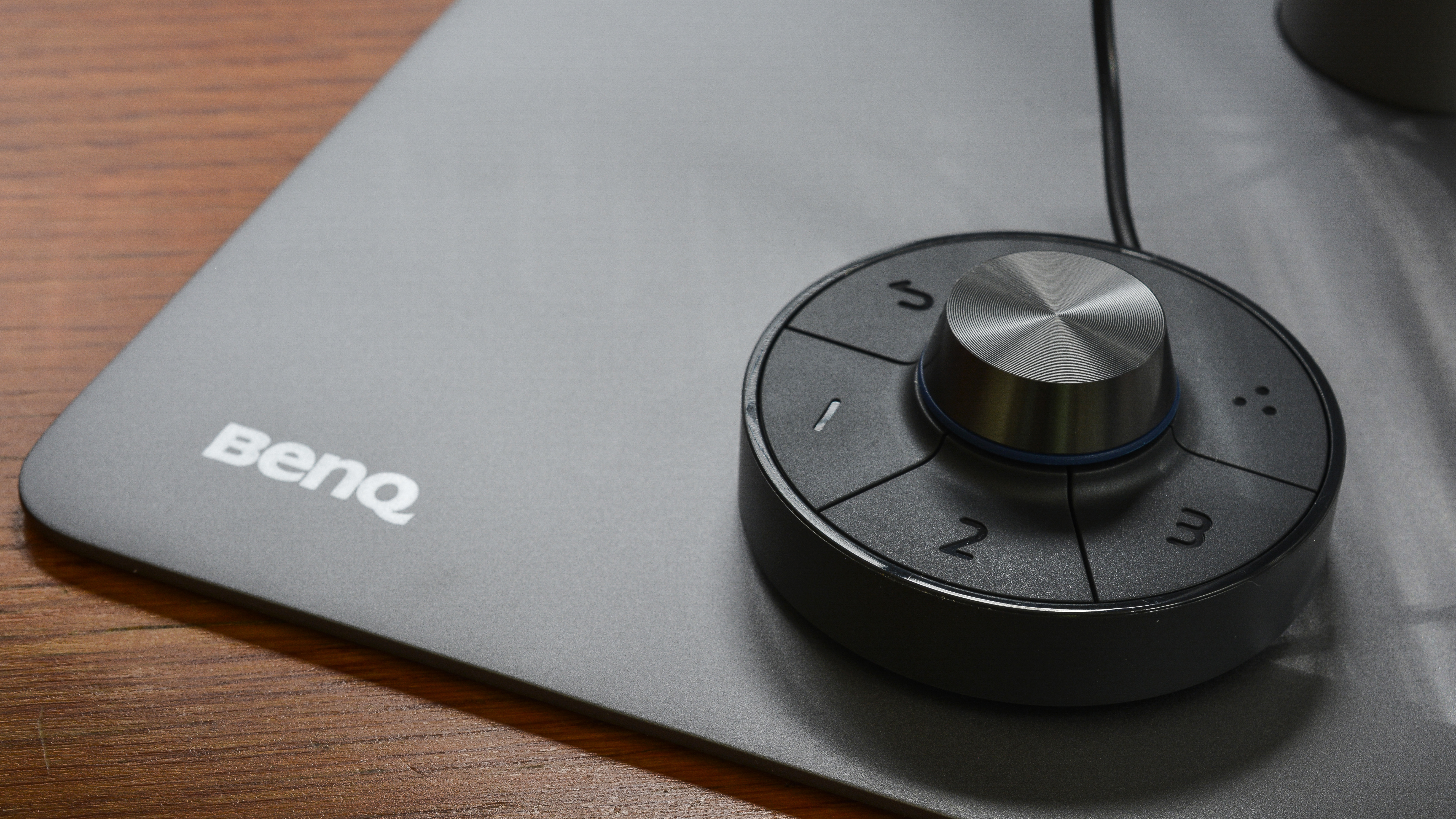
The panel’s bezels are super-thin with the physical controls arranged behind the bottom right edge and which includes a little joystick-type controller for navigating the on-screen menus. The alternative means of operation is the current version of BenQ’s ‘Hotkey Puck’ which is a handy wired remote controller. It allows for faster and easier navigation of the on-screen menus as well as, probably even more conveniently, quicker switching between assigned color modes (for example, sRGB and B&W).
This monitor also has a Keyboard Video Mouse (KVM) which allows for easier switching between two computers or two monitors. There’s a ‘DualView’ mode for when you’re using one display with two inputs. Here then, the PD3220U has appeal for both designers and photographers, enhanced by the provision of the much faster and higher bandwidth Thunderbolt 3 connectivity via its pair of USB Type C ports. A Thunderbolt 3 cable is supplied with the monitor. This allows for the single cable transmission of both data and power (up to 85 watts through one of the connections), greatly simplifying the daisy-chaining of two 4K monitors… so, for example, you can display a big image across the two displays. USB C doesn’t have the bandwidth to support two 4K displays.
Specifications
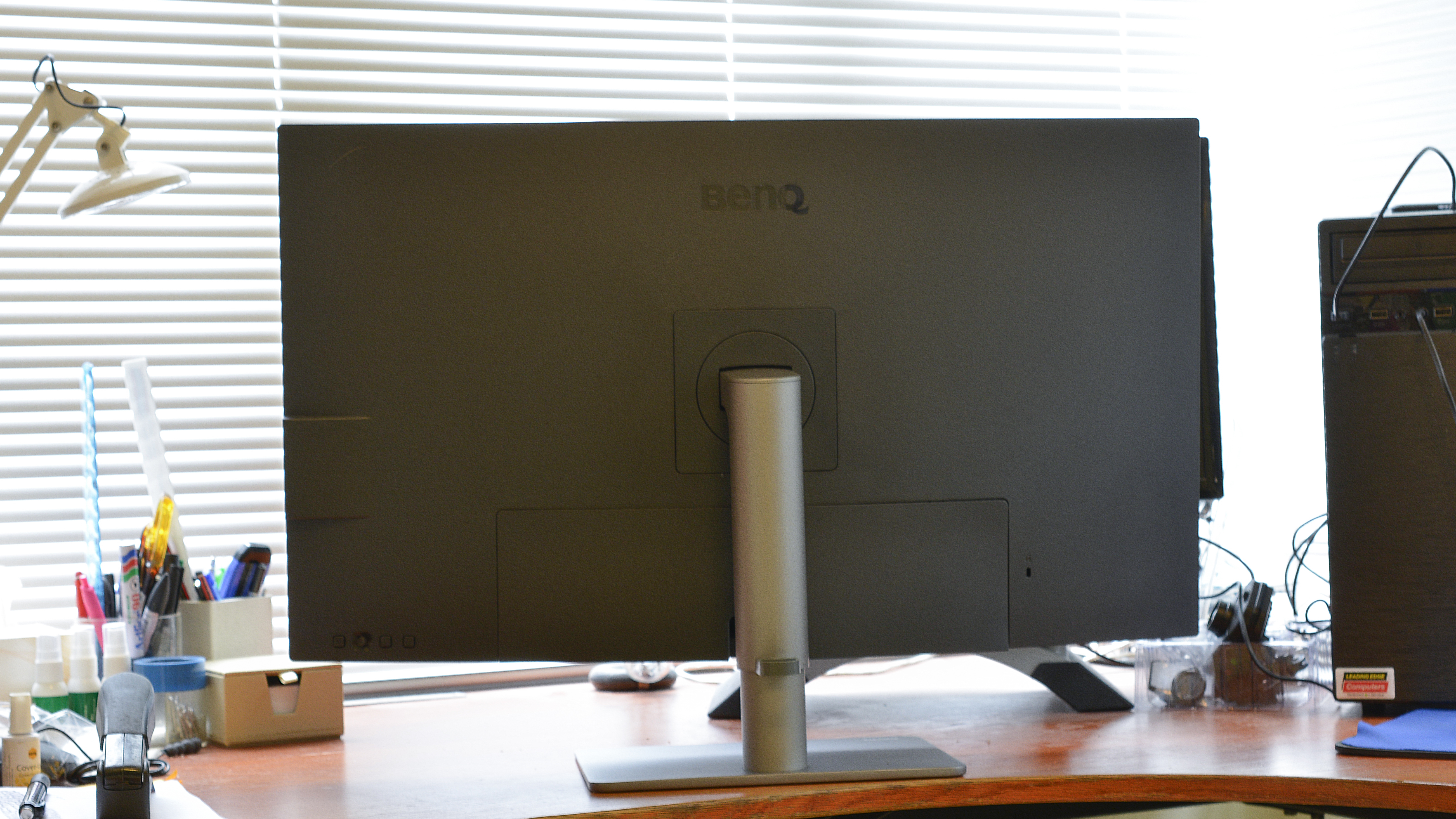
Panel size: 31.5 inch
Panel Type: IPS with white LED backlighting
Resolution: 3840x2160 pixels (140 ppi)
Brightness: 250cd/m²
Contrast: 1000:1
Pixel Response: 5ms
Color Coverage: 100 percent sRGB, 100 percent Rec.709, 95 percent DCI-P3, 80 percent Adobe RGB.
Refresh rate: 60 Hz
Vesa: 100mm x 100mm
Inputs: Display Port 1.2, Mini Display Port 1.2, two HDMI 2.0, USB 3.1 hub (4 downstream and 1 upstream), USB mini B, two USB Type C with Thunderbolt 3 connectivity, 3.5 mm stereo headphone output.
Performance
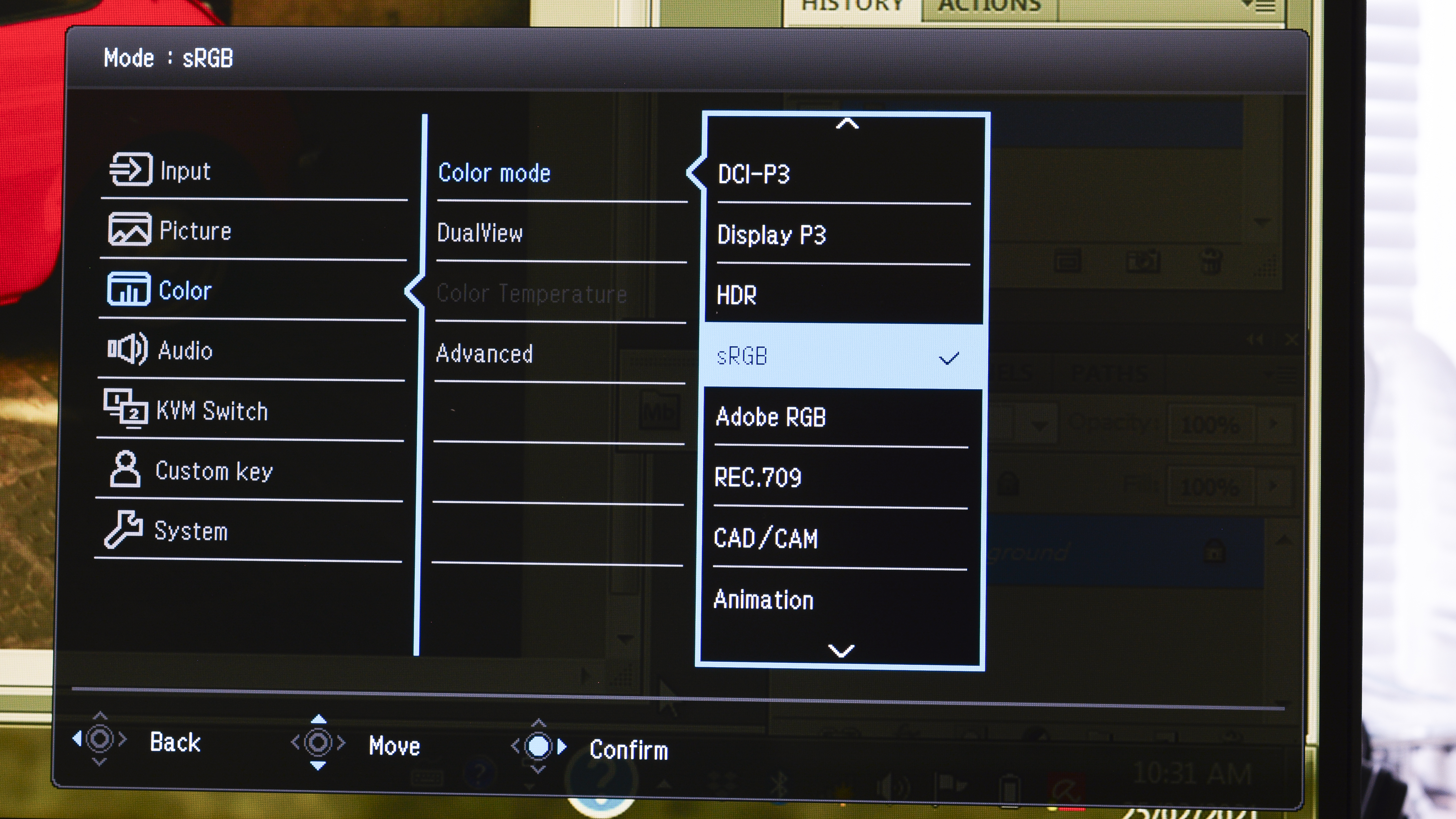
The PD3220U’s display has 10-bit color processing which delivers a palette of 1.07 billion, resulting in smoother shading, color transitions and tonal gradations. The In-Plane Switching (IPS) technology enables a fast response time of 5.0 ms – an important spec for video-makers in particular – and gives a wide viewing angle of 178 degrees.
In terms of reproducible colors, the panel delivers 100 percent of the sRGB color space and its video equivalent, Rec.709 which is the standard for color reproduction on transmissive displays, including tablets and smartphones. The display also covers 95 percent of DCI-P3 which is a cinematographic color space (but also the color space of Mac computers). For video-makers, the PD3220U also handles HDR content via HDR10 support.
BenQ doesn’t supply a specification for the Adobe RGB color space which is used by photographers for printing as it has a wider gamut. If most of your work is ending up online and on electronic displays then sRGB is the standard. You could certainly still use the PD3220U for print preparation, but its Adobe RGB coverage isn’t as wide as that of a dedicated photo monitor (we tested it at around 87 percent which is actually a bit better than the quoted spec), but the overall accuracy of its color reproduction thanks to the factory calibration is still a good start. Incidentally, while this monitor doesn’t support hardware calibration you can still perform software-based calibration with a colorimeter – such as Datacolor’s Spyder X – which will ensure that the monitor is kept within specifications over time.
As usual, we tested the monitor’s via software-based calibration using the SpyderX Elite colorimeter and DisplayCal measurements for colour gamut, tone response, white point uniformity, contrast, luminance uniformity, colour uniformity and colour accuracy. The PD3220U scored well in all these tests so it’s more than capable of meeting the demands of many photographers.
Purely subjectively, the test images we displayed were very accurately rendered with good saturation and fidelity, nicely smooth gradations, a wide dynamic range and crisply resolved detailing.
Verdict

For photographers who don’t plan to do a lot of printing, the BenQ PD3220U has everything they need for the processing and presentation of images. It represents a significant saving over the comparable photo monitor from BenQ (and others), but still offers exceptional workflow efficiencies and great flexibility for both Mac and Windows users. It’s also an excellent monitor for video editing which is becoming another important consideration for photographers these days (in reality probably more so than making prints). Overall though, it’s the value-for-money proposition that’s the hardest to ignore given the performance so, while it might say “Designer Monitor” on the box, the PD3220U is more than capable of delivering as photo/video monitor too.
Read more
• Best monitors for photo editing
• Best USB-C monitors
• How to calibrate a monitor
• Best monitor calibrators
• Best 8K monitors
• Best video editing monitors
• Best ultrawide monitors
• Best portable monitors
• Best TV for a computer monitor

Paul has been writing about cameras, photography and photographers for 40 years. He joined Australian Camera as an editorial assistant in 1982, subsequently becoming the magazine’s technical editor, and has been editor since 1998. He is also the editor of sister publication ProPhoto, a position he has held since 1989. In 2011, Paul was made an Honorary Fellow of the Institute Of Australian Photography (AIPP) in recognition of his long-term contribution to the Australian photo industry. Outside of his magazine work, he is the editor of the Contemporary Photographers: Australia series of monographs which document the lives of Australia’s most important photographers.
